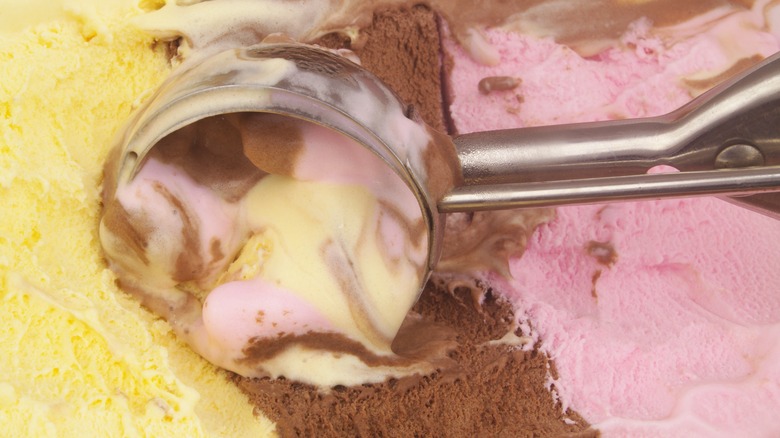The Flavor Difference Between Spumoni And Neapolitan Ice Cream
Most ice cream flavors aren't confusing. When you order chocolate, vanilla, strawberry, and mint chocolate chip, for example, you know exactly what you're getting. But when you move beyond the basics — namely, into combinations of different varieties that make up a whole new flavor themselves — you dip your toe into confusing territory. So while you may be tempted to try spumoni and Neapolitan ice cream, you may not know exactly what you'll be tasting at first glance.
Even right off the bat, the similarities between these two are fairly obvious. They're both a pretty rainbow of different flavors, arranged side by side instead of all mixed together. You may see them presented in blocks, which show off their colorful stripes. And both types of desserts have Italian roots. The differences lie in exactly what flavors make up the overall treat, the extra ingredients involved (or lack thereof), and the origin story of each one. So if you're not sure whether to dabble in spumoni or Neapolitan ice cream, we'll dive into the specific distinctions between these two desserts here.
What is spumoni?
Technically, spumoni isn't an ice cream flavor — it's a dessert in its own right. It's made of layered gelato, plus quite a few other toppings and mix-ins. However, some versions in the U.S. now just use ice cream for the base instead. Yet while classic spumoni is its own sliced treat in Italy, American adaptations have turned it into an ice cream flavor that you can serve out of a cup or cone, just like other types.
As with any delicious gelato-based treat, spumoni has roots in Italy (specifically Naples). Its name comes from the Italian word "spumone," which translates to "foam" in English. When exactly it migrated to the U.S. is a little unclear, but it's likely that it took off in the late 1800s or early 1900s. According to one account, Italian immigrants named Salvatore and Lucia Lezza brought it over in 1905, where it became known as Neapolitan ice cream in Chicago. It's possible that Neapolitan ice cream was actually an adaptation of spumoni once Italians came to the U.S., as they were trying to market specific flavors to Americans.
What is Neapolitan ice cream?
Just like spumoni, Neapolitan ice cream is a layered and sliced treat with three flavors. But unlike its dessert cousin, the focus here is on the ice cream, and you won't see as many embellishments like toppings or mix-ins. While it's classically served in blocks (aka slices) as well, the flavor combination has been adapted into all kinds of different forms in the U.S. — including an In-N-Out secret menu milkshake (in which the different ice creams are actually all blended together) and Christmas Neapolitan cake.
Neapolitan ice cream is, of course, named after the people of Naples who spread their love of a tri-layered frozen dessert (likely spumoni at first) around the world. Naples can also be credited for giving us the first recorded recipe of the modern-day version of ice cream in the 1600s. Then a bit later in the early 1800s, a man named Giuseppe Tortoni publicized the treat in Paris, before it ever came to the U.S. However, the term "Neapolitan-style ice cream" was widely used by Americans to describe new types of ice cream from Italian immigrants at the turn of the 20th century. And when one version of spumoni became popular with Americans, Neapolitan ice cream was the name that stuck.
Spumoni and Neapolitan ice cream have three layers, but with different flavors
The main difference between spumoni and Neapolitan ice cream comes down to the flavors used, although each type offers a little wiggle room nowadays. In the U.S., spumoni typically includes pistachio, chocolate, and cherry gelato (or ice cream). But sometimes the chocolate is swapped out for vanilla since the resulting colors (white, green, and red) mimic the Italian flag. An almond cream layer can also be used in the place of classic vanilla, while some versions add the almond extract into the cherry layer, creating a cherry-almond ice cream. However, the original recipe brought over from Italy consisted of almond, chocolate, and stracciatella (a sweet cream base with chocolate chips).
Neapolitan ice cream, on the other hand, usually sticks to three core flavors: chocolate, vanilla, and strawberry. The reason for the switch may have been that strawberries were easier to come by than cherries back in the day, and pistachio wasn't as popular of a choice for Americans. Today, the Neapolitan combination is still beloved in the U.S., coming in at No. 10 on Stacker's list of the most popular ice cream flavors in America in 2023 (although we demoted it to the 22nd spot when ranking 32 popular ice cream flavors).
Spumoni gets dressed up with mix-ins and toppings
While the flavors involved are the main difference between spumoni and Neapolitan ice cream, there are other elements included in the former that you typically won't see in the latter — namely, mix-ins and toppings. Spumoni isn't shy about incorporating ingredients into the layers that represent each flavor. For instance, some recipes include actual pistachios, whole maraschino cherries, and chocolate chips, separated by each strip of the dessert. In addition, you may also find your slices with mix-ins and toppings like whipped cream, more maraschino cherries, chocolate syrup, and crushed cookies. Yet while whipped cream can be used as a garnish, it's also sometimes mixed into the ice cream itself to create an airier texture (and to honor the dessert's foamy namesake).
On the flip side, you'll generally only see Neapolitan ice cream with a smooth consistency free of extras. Any toppings are usually the same as what you can get from an American ice cream shop, but they're not necessarily specific to this flavor. However, you may see red food coloring used as an ingredient to give the strawberry portion its signature pink color, which creates another way for this flavor to appeal to its core American audience.




